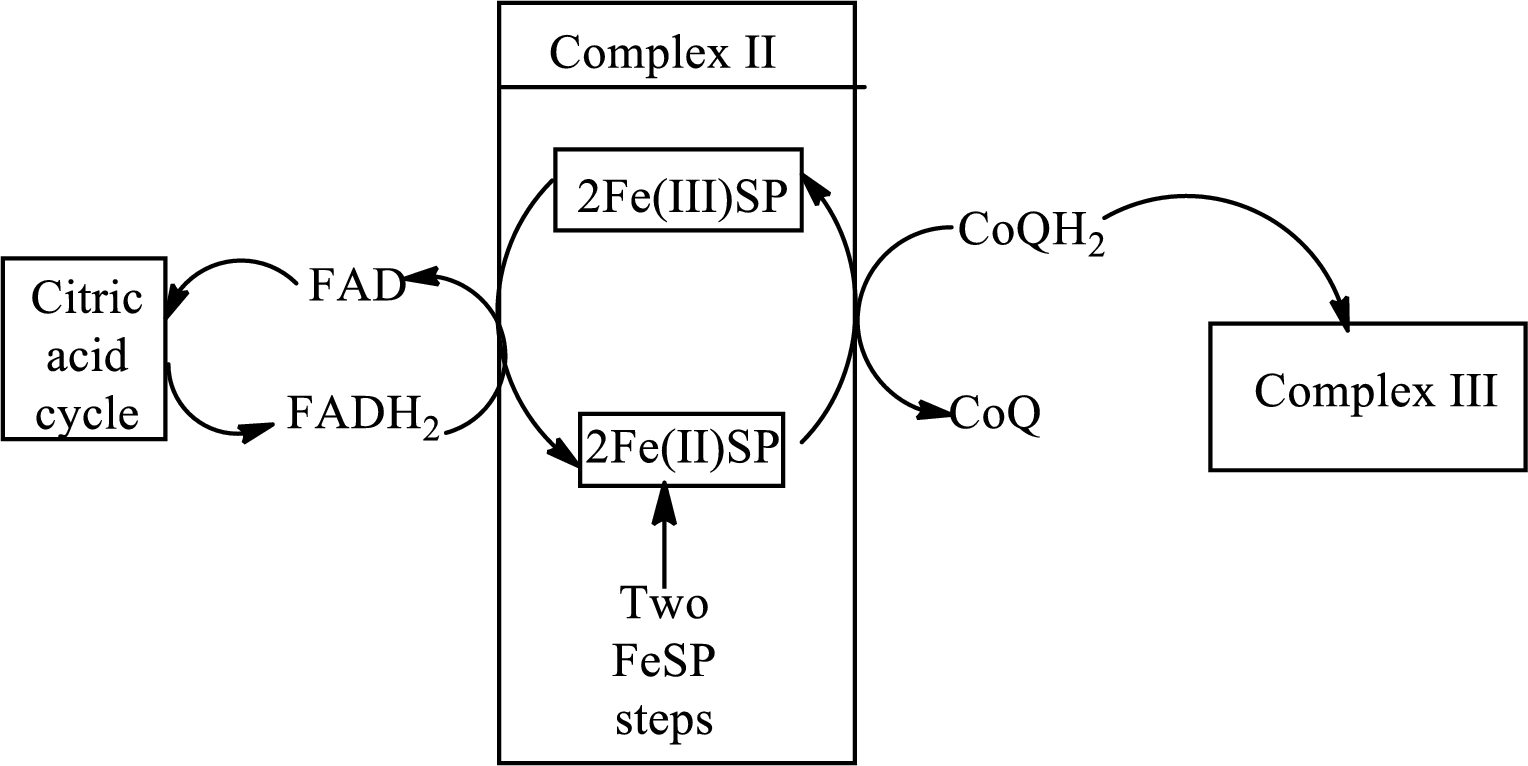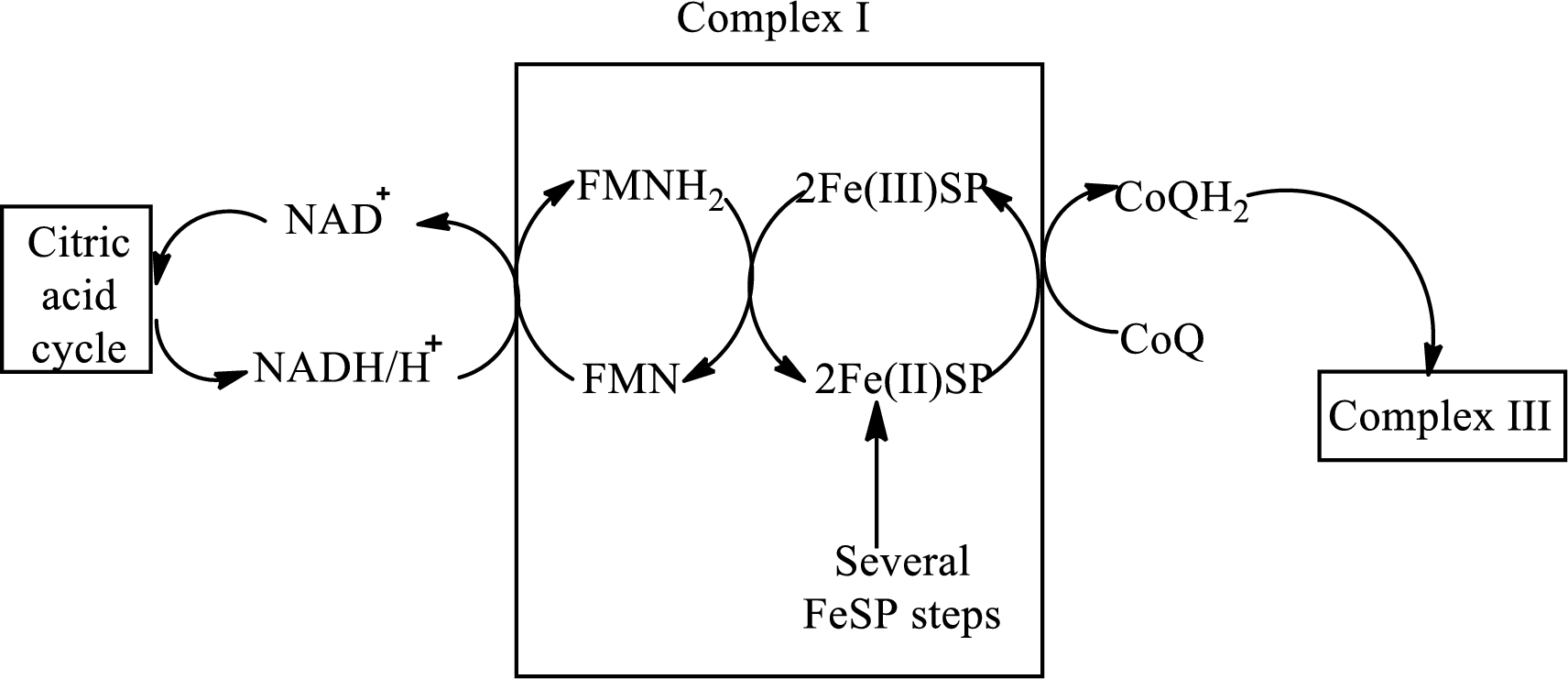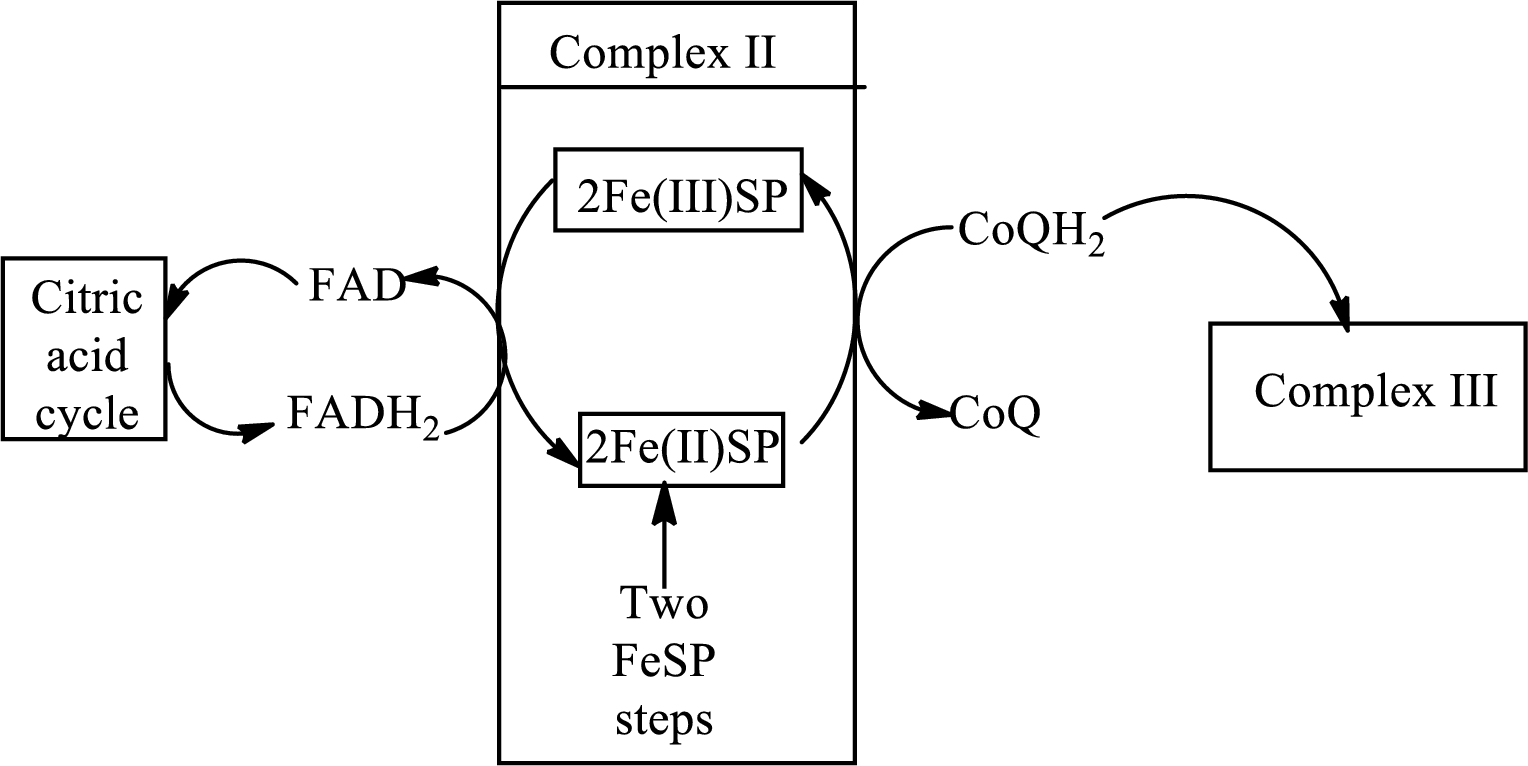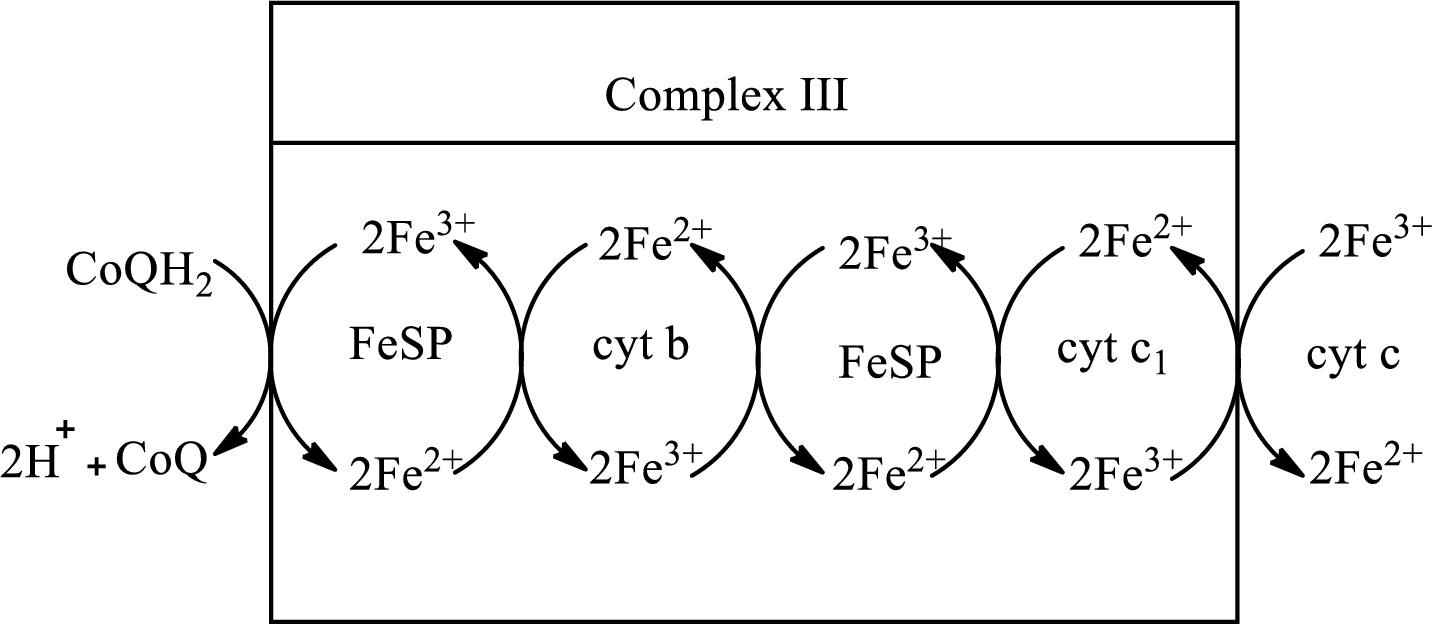
Concept explainers
(a)
Interpretation: To indicate whether oxaloacetate undergoes (1) oxidation but not reduction, (2) reduction but not oxidation, (3) both oxidation and reduction or (4) neither oxidation nor reduction in the common
Concept introduction: Common metabolic pathway is the total sum of metabolic reactions that occur in stage third and fourth of the biochemical process or it is defined as the total sum of reactions that occur in the citric acid cycle and electron transport chain and oxidative phosphorylation.
These stages are included in the common metabolic pathway because the reactions in these stages are the same for different kinds of food.
The citric acid cycle is the third stage of the biochemical energy production process. The cycle includes the reactions in which the acetyl part of acetyl CoA is oxidized and leads to the formation of carbon dioxide and
Electron transport chain is a sequence of biochemical reactions in which electrons and hydrogen atoms from the citric acid cycle are transferred to various intermediate carriers and finally reacts with molecular oxygen to form a water molecule.
(a)
Answer to Problem 23.103EP
Oxaloacetate undergoes neither oxidation nor reduction in the common metabolic pathway.
Explanation of Solution
Oxaloacetate undergoes condensation reaction in the first step of the citric acid cycle.
The first step involves the condensation reaction of oxaloacetate and

(b)
Interpretation: To indicate whether
Concept introduction: Common metabolic pathway is the total sum of metabolic reactions that occur in stage third and fourth of the biochemical process or it is defined as the total sum of reactions that occur in the citric acid cycle and electron transport chain and oxidative phosphorylation.
These stages are included in the common metabolic pathway because the reactions in these stages are the same for different kinds of food.
The citric acid cycle is the third stage of the biochemical energy production process. The cycle includes the reactions in which the acetyl part of acetyl CoA is oxidized and leads to the formation of carbon dioxide and
Electron transport chain is a sequence of biochemical reactions in which electrons and hydrogen atoms from the citric acid cycle are transferred to various intermediate carriers and finally reacts with molecular oxygen to form a water molecule.
(b)
Answer to Problem 23.103EP
Explanation of Solution
Nicotinamide adenine dinucleotide exists in two forms: oxidized form
The reaction of step 3 is:

The reaction of step 4 is:

The reaction of step 8 is:

(c)
Interpretation: To indicate whether FADH2 undergoes (1) oxidation but not reduction, (2) reduction but not oxidation, (3) both oxidation and reduction, or (4) neither oxidation nor reduction in the common metabolic pathway.
Concept introduction: Common metabolic pathway is the total sum of metabolic reactions that occur in stage third and fourth of the biochemical process or it is defined as the total sum of reactions that occur in the citric acid cycle and electron transport chain and oxidative phosphorylation.
These stages are included in the common metabolic pathway because the reactions in these stages are the same for different kinds of food.
The citric acid cycle is the third stage of the biochemical energy production process. The cycle includes the reactions in which the acetyl part of acetyl CoA is oxidized and leads to the formation of carbon dioxide and
Electron transport chain is a sequence of biochemical reactions in which electrons and hydrogen atoms from the citric acid cycle are transferred to various intermediate carriers and finally reacts with molecular oxygen to form a water molecule.
(c)
Answer to Problem 23.103EP
FADH2 undergoes oxidation in the common metabolic pathway.
Explanation of Solution
FADH2is the reduced form of flavin adenine dinucleotide. The main function of flavin adenine dinucleotide is to act as an oxidizing agent and used by the cell in oxidation reactions like oxidation of fatty acid. The reaction of the oxidation of FADH2 is:
FADH2undergoes oxidation in complex II of the electron transport chain.
Complex II consists of four subunits in its structure. This complex interacts initially with the electrons that are coming after the reduction of FADH2. FADH2 is oxidized to form FAD in this reaction. The diagrammatic representation of electron transfer in complex II in the electron transfer chain is:

(d)
Interpretation: To indicate whether
Concept introduction: Common metabolic pathway is the total sum of metabolic reactions that occur in stage third and fourth of the biochemical process or it is defined as the total sum of reactions that occur in the citric acid cycle and electron transport chain and oxidative phosphorylation.
These stages are included in the common metabolic pathway because the reactions in these stages are the same for different kinds of food.
The citric acid cycle is the third stage of the biochemical energy production process. The cycle includes the reactions in which the acetyl part of acetyl CoA is oxidized and leads to the formation of carbon dioxide and
Electron transport chain is a sequence of biochemical reactions in which electrons and hydrogen atoms from the citric acid cycle are transferred to various intermediate carriers and finally reacts with molecular oxygen to form a water molecule.
(d)
Answer to Problem 23.103EP
Explanation of Solution
Complex I consists of more than 40 structural subunits. Its structure has B-vitamin-containing flavin mononucleotide
The diagrammatic representation of electron transfer in complex I in the electron transfer chain is as follows:

Complex II consists of four subunits in its structure. This complex interacts initially with the electrons that are coming after the reduction of FADH2. FADH2 produced in the citric acid cycle transfers the electron to the complex II. The diagrammatic representation of electron transfer in complex II in the electron transfer chain is:

Complex III consists of 11 structural subunits. Its structural subunits contain iron-sulfur proteins and various cytochromes.

Want to see more full solutions like this?
Chapter 23 Solutions
Bundle: General, Organic, and Biological Chemistry, 7th + OWLv2 Quick Prep for General Chemistry, 4 terms (24 months) Printed Access Card
- The quantum yield of the photochemical decay of HI is 2. Calculating the moles of HI per kJ of radiant energy can be decayed knowing that the energy absorbed per mole of photons is 490 kJ.arrow_forwardThe quantum yield of the photochemical decay of HI is 2. Calculate the number of Einsteins absorbed per mole knowing that the energy absorbed per mole of photons is 490 kJ.arrow_forwardThe quantum yield of the photochemical decay of HI is 2. How many moles of HI per kJ of radiant energy can be decayed knowing that the energy absorbed per mole of photons is 490 kJ.arrow_forward
- If the energy absorbed per mole of photons is 450 kJ, the number of Einsteins absorbed per 1 mole.arrow_forwardWhen propionic aldehyde in vapor form at 200 mmHg and 30°C is irradiated with radiation of wavelength 302 nm, the quantum yield with respect to the formation of CO is 0.54. If the intensity of the incident radiation is 1.5x10-3 W, find the rate of formation of CO.arrow_forwardDraw mechanismarrow_forward
- Does Avogadro's number have units?arrow_forwardExplain why the total E in an Einstein depends on the frequency or wavelength of the light.arrow_forwardIf the dissociation energy of one mole of O2 is 5.17 eV, determine the wavelength that must be used to dissociate it with electromagnetic radiation. Indicate how many Einstein's of this radiation are needed to dissociate 1 liter of O2 at 25°C and 1 atm of pressure.Data: 1 eV = 96485 kJ mol-1; R = 0.082 atm L K-1; c = 2.998x108 m s-1; h = 6.626x10-34 J s; NA = 6.022x 1023 mol-1arrow_forward
- Indicate the number of Einsteins that are equivalent to 550 kJ mol⁻¹ of absorbed energy (wavelength 475 nm).arrow_forwardIndicate the number of einsteins that are equivalent to 550 kJ mol⁻¹ of absorbed energy?arrow_forwardA unit used in photochemistry is the einstein. If 400 kJ mol-1 of energy has been absorbed, how many einsteins is this equivalent to?arrow_forward
 Chemistry In FocusChemistryISBN:9781305084476Author:Tro, Nivaldo J., Neu, Don.Publisher:Cengage Learning
Chemistry In FocusChemistryISBN:9781305084476Author:Tro, Nivaldo J., Neu, Don.Publisher:Cengage Learning Chemistry for Today: General, Organic, and Bioche...ChemistryISBN:9781305960060Author:Spencer L. Seager, Michael R. Slabaugh, Maren S. HansenPublisher:Cengage Learning
Chemistry for Today: General, Organic, and Bioche...ChemistryISBN:9781305960060Author:Spencer L. Seager, Michael R. Slabaugh, Maren S. HansenPublisher:Cengage Learning General, Organic, and Biological ChemistryChemistryISBN:9781285853918Author:H. Stephen StokerPublisher:Cengage Learning
General, Organic, and Biological ChemistryChemistryISBN:9781285853918Author:H. Stephen StokerPublisher:Cengage Learning Organic And Biological ChemistryChemistryISBN:9781305081079Author:STOKER, H. Stephen (howard Stephen)Publisher:Cengage Learning,
Organic And Biological ChemistryChemistryISBN:9781305081079Author:STOKER, H. Stephen (howard Stephen)Publisher:Cengage Learning, Introduction to General, Organic and BiochemistryChemistryISBN:9781285869759Author:Frederick A. Bettelheim, William H. Brown, Mary K. Campbell, Shawn O. Farrell, Omar TorresPublisher:Cengage LearningChemistry: Matter and ChangeChemistryISBN:9780078746376Author:Dinah Zike, Laurel Dingrando, Nicholas Hainen, Cheryl WistromPublisher:Glencoe/McGraw-Hill School Pub Co
Introduction to General, Organic and BiochemistryChemistryISBN:9781285869759Author:Frederick A. Bettelheim, William H. Brown, Mary K. Campbell, Shawn O. Farrell, Omar TorresPublisher:Cengage LearningChemistry: Matter and ChangeChemistryISBN:9780078746376Author:Dinah Zike, Laurel Dingrando, Nicholas Hainen, Cheryl WistromPublisher:Glencoe/McGraw-Hill School Pub Co





